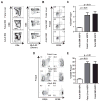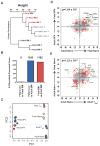Fetal and adult hematopoietic stem cells give rise to distinct T cell lineages in humans
- PMID: 21164017
- PMCID: PMC3276679
- DOI: 10.1126/science.1196509
Fetal and adult hematopoietic stem cells give rise to distinct T cell lineages in humans
Erratum in
- Science. 2011 Feb 4;331(6017):534
Abstract
Although the mammalian immune system is generally thought to develop in a linear fashion, findings in avian and murine species argue instead for the developmentally ordered appearance (or "layering") of distinct hematopoietic stem cells (HSCs) that give rise to distinct lymphocyte lineages at different stages of development. Here we provide evidence of an analogous layered immune system in humans. Our results suggest that fetal and adult T cells are distinct populations that arise from different populations of HSCs that are present at different stages of development. We also provide evidence that the fetal T cell lineage is biased toward immune tolerance. These observations offer a mechanistic explanation for the tolerogenic properties of the developing fetus and for variable degrees of immune responsiveness at birth.
Figures




Comment in
-
Immunology. Have you seen your mother, baby..Science. 2010 Dec 17;330(6011):1635-6. doi: 10.1126/science.1200406. Science. 2010. PMID: 21164004 No abstract available.
-
Haematopoiesis: Baby tolerance.Nat Rev Immunol. 2011 Feb;11(2):78. doi: 10.1038/nri2923. Epub 2011 Jan 21. Nat Rev Immunol. 2011. PMID: 21467984 No abstract available.
-
Fetal T cells and immunological tolerance.Am J Transplant. 2012 Mar;12(3):511. doi: 10.1111/j.1600-6143.2012.04023.x. Am J Transplant. 2012. PMID: 22372458 No abstract available.
References
-
- Silverstein AM. Ontogeny of the immune response. Science. 1964;144:1423. - PubMed
-
- Billingham RE, Brent L, Medawar PB. Actively acquired tolerance of foreign cells. Nature. 1953;172:603. - PubMed
-
- Brent L, et al. On the feasibility of inducing tolerance in man: a study in the cynomolgus monkey. Immunol Lett. 1989;21:55. - PubMed
-
- Claas FH, Gijbels Y, van der Velden-de Munck J, van Rood JJ. Induction of B cell unresponsiveness to noninherted maternal HLA antigens during fetal life. Science. 1988;241:1815. - PubMed
-
- Burlingham WJ, et al. The effect of tolerance to noninherited maternal HLA antigens on the survival of renal transplants from sibling donors. N Engl J Med. 1998;339:1657. - PubMed
Publication types
MeSH terms
Associated data
- Actions
Grants and funding
LinkOut - more resources
Full Text Sources
Other Literature Sources
Medical
Molecular Biology Databases

